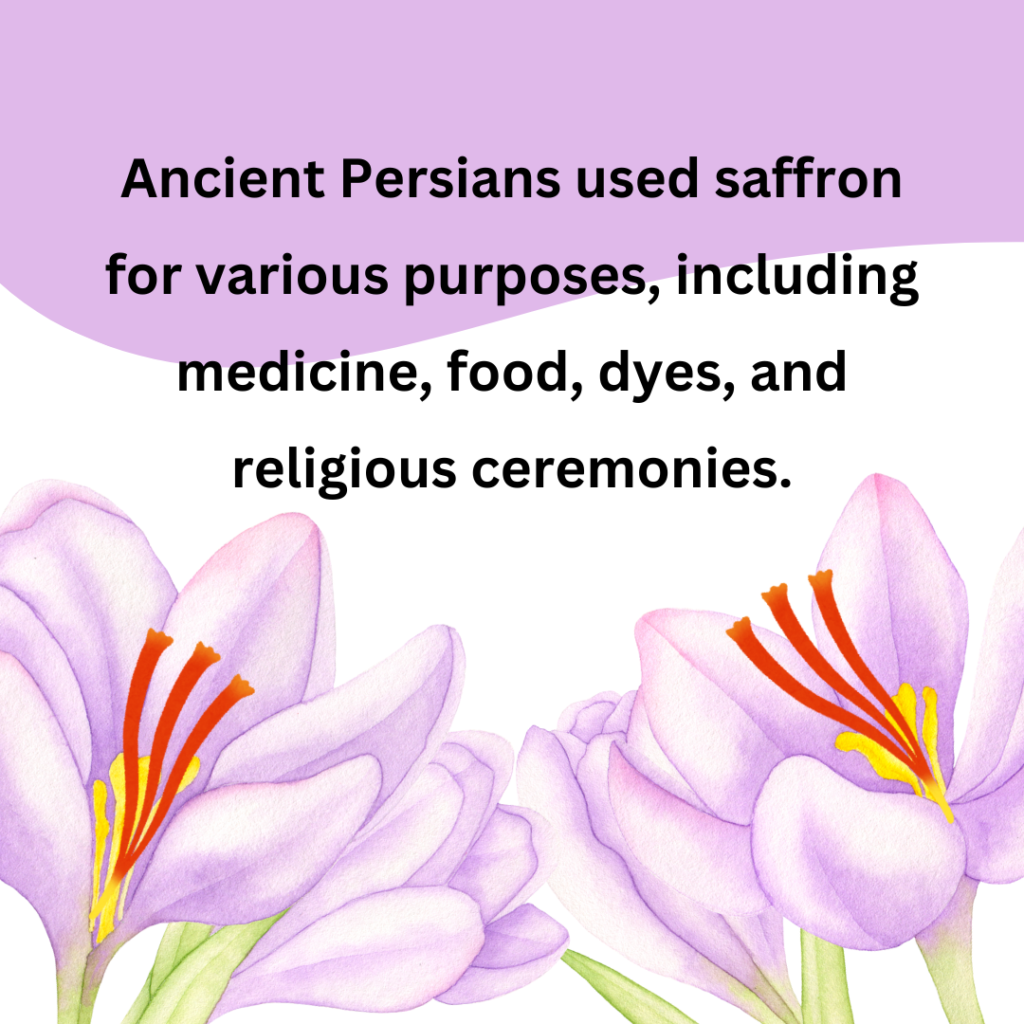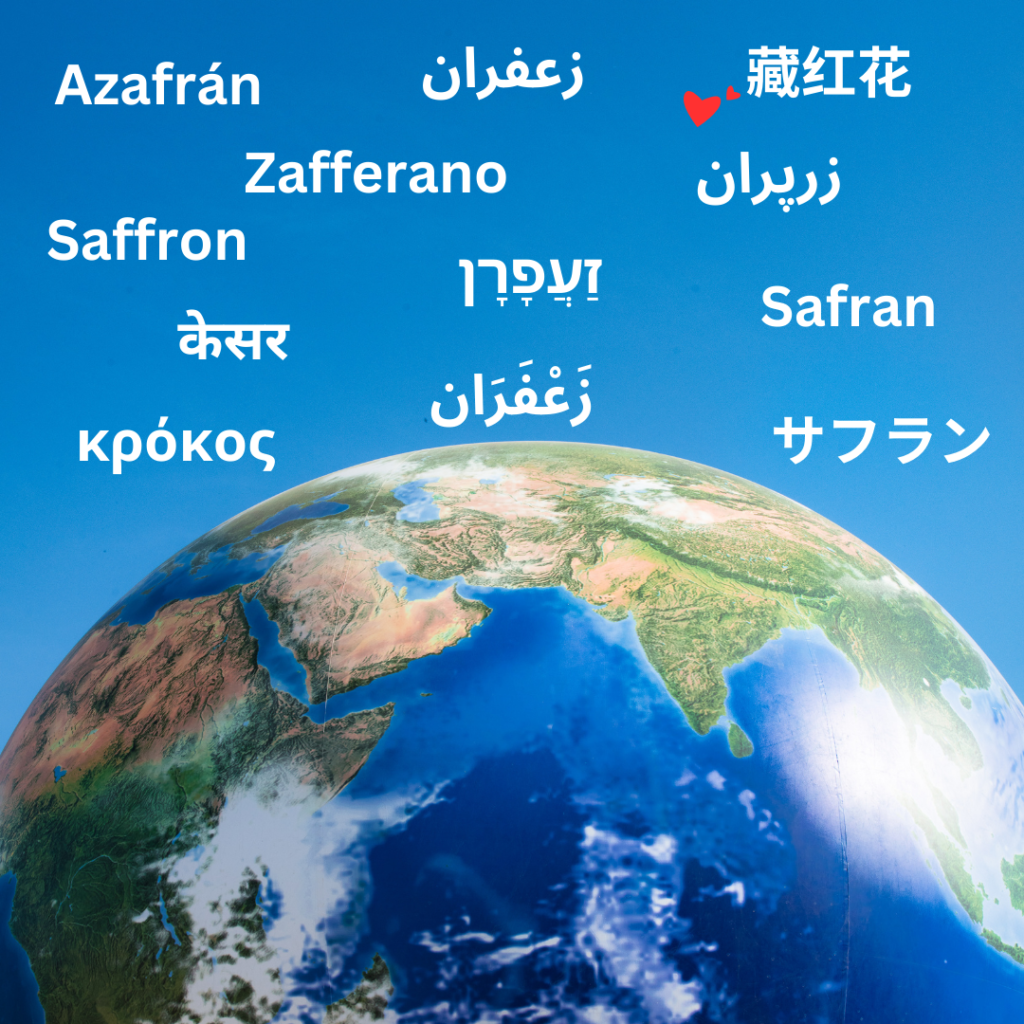The Origin of Saffron: Dating Back Thousands of Years

When investigating saffron’s roots, various countries are mentioned as potentially being the first to cultivate the saffron plant or discover its threads. These countries include Iran, Greece, Afghanistan, Spain and Kashmir. The exact path saffron took to spread globally might not be the focus, but what’s important is that people worldwide now appreciate this remarkable plant for its color, taste, and scent in their cooking and desserts, as well as for its medicinal uses. This article will explore certain facets about the origin of saffron and its historical background.
Saffron: A Journey Through History and Cultures
Saffron comes from a flower called Crocus cartwrightianus, found in Greece and Crete. This flower is believed to be the wild ancestor of the saffron crocus, known as Crocus sativus. Saffron has a long history, with its use dating back to ancient times. In ancient Greece, saffron was highly valued for its color and fragrance. There are stories about saffron’s origins, like the legend of Crocus and Smilax, where a youth turns into a saffron flower after a tragic love story.
Today, saffron continues to be prized for its flavor, color, and medicinal properties.
The Historical Use of Saffron
The use of saffron dates back to ancient times, even appearing in prehistoric cave paintings in modern-day Iraq. Sumerians used saffron in remedies and magical potions, believing in its divine healing properties. It was traded over long distances before the Minoan palace culture reached its peak. In ancient Hebrew texts, saffron (karkom) is praised for its sweet scent, and it was even used in the Temple in Jerusalem.
In the past, saffron was used in creative ways beyond just cooking. It was scattered in Roman public areas to freshen the air and was even thought to be an antidote for the bubonic plague.
During the Middle Ages, saffron gained popularity not only as a medicine but also as a food coloring, especially for elaborate feasts. For example, a recipe from a 14th-century cookbook describes how to prepare a swan by glazing it with saffron during cooking and then decorating it with a paste made of egg yolks, saffron, and honey.
Romans and Greeks used saffron for perfumes, deodorizers, and even in their baths.
In ancient Persia, saffron was cultivated and used in royal carpets, funeral shrouds, and as a ritual offering to deities. It was also valued for its medicinal properties, believed to cure melancholy and used as a body wash after heavy work.
Alexander the Great and his soldiers used saffron during their campaigns, believing in its healing powers and incorporating it into their diets and baths.
According to Persian records, saffron, along with other spices, was introduced to India by Persian rulers who transplanted saffron crocus across their empire. Phoenicians then traded Kashmiri saffron in the 6th century BC, where it was used for treating melancholy and dyeing fabric.
Saffron and culture
Saffron holds profound cultural and religious significance beyond its traditional uses in cooking and textiles. Referenced in ancient texts like the Song of Solomon, it is intertwined with rituals and ceremonies in Greek and Roman cultures. The streets of Rome were adorned with saffron during grand processions, underscoring its esteemed status over the ages.
Ancient Persians used saffron for various purposes, including medicine, food, dyes, and religious ceremonies.

Following the passing of Buddha, his followers adopted saffron as the color of their robes, highlighting its spiritual significance. Additionally, saffron has adorned royal clothing across various cultures. Legends even attribute Cleopatra’s beauty regimen to saffron-infused mare’s milk.
Moreover, saffron found its way into cosmetics in antiquity, such as lipstick made with a mixture of saffron, red ochre, tallow, and beeswax. Medieval monks utilized saffron to create yellow glazes for their manuscripts, showcasing its versatility and historical importance.
The Etymology of Saffron
What is the origin of saffron’s name? The term “saffron” originates directly from the Latin word safranum, evolving through the Old French term safran in the 12th century. This French term was adopted from the Arabic word زَعْفَرَان (za’farān), and ultimately derives from the Persian word زَرپَران (zarparān), translating to “golden leaves”.
In different places, it was known as “safrà” in Catalonia, “zafferano” in Italy, “açafrão” in Portugal, and “azafrán” in Spain.
Another word, “crocus,” also joined saffron’s journey, originating from Aramaic, passing through Arabic and Greek, and possibly connecting to Sanskrit. Though its origins may be mysterious, saffron’s story reminds us of the richness of language and culture across the world.

Saffron Today
The Saffron crocus is a triploid plant, meaning it has three sets of chromosomes instead of the usual two. This genetic makeup renders it sterile, unable to produce viable seeds. As a result, saffron can only be propagated through daughter corms, which are underground storage organs. Because of this method of reproduction, all saffron plants today are essentially clones of each other, lacking genetic diversity. Identifying the original plant species could allow farmers to discover new genetic variations and introduce diversity, potentially leading to improved saffron cultivars.
Iran produces most of the world’s saffron, more than 80%, says the UN Food and Agriculture Organization. This is because Iran has a dry, sunny climate, and farmers there have passed down their knowledge for generations.
Primarily cultivated in Iran, saffron is also grown in Afghanistan, Kashmir, Spain, France, Italy, Morocco and India. Harvesting saffron is a labor-intensive process, with workers carefully handpicking the delicate stigmas from each flower. It takes an astounding 75,000 blossoms to yield just one pound of saffron. This spice contains essential oils and pigments like picrocrocin and crocin, contributing to its unique flavor and color.
Last Words
For over 3,500 years, people worldwide have cultivated and used saffron, a precious spice derived from the dried stigmas of the saffron crocus flower. Known for its bitter taste, hay-like scent, and medicinal properties, saffron has remained one of the world’s most expensive substances. The origin of saffron likely trace back to wild species like Crocus cartwrightianus in Greece. Although its precise origin remains debated, saffron has historical ties to regions like Iran, Greece, Mesopotamia, and Kashmir.



